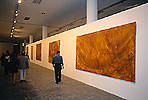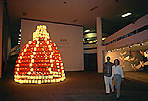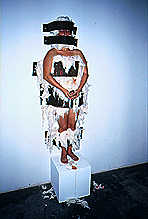
|
|
Dec. 10, 1996
|
Art Watch Index - Dec. 3, 1996
![]()
The 23rd São Paulo Biennale

The exhibits of the 23rd São Paulo Biennale.
The work of Masato Kobayashi, a painter representing Japan. He questions the meaning of the painting through his warped canvas and the surface which reminds us of the "origin of figurative painting".
Mural by Sol Lewitt, the master artist representing the United States. Seven star shapes in brilliant colors.
The exhibits from the "Asian" section in the
"Universalis" Exhibition, where several artists each from
7 regions of the world participate.
The work by Jheon Soo Cheon from Korea exhibited in the "Asian" section of "Universalis", is an installation of a wooden cottage placed on a foundation made of crushed cans (refer to text). The photograph is the interior of the cottage. A cocoon-like New Year's decoration is laid on the floor, and video monitors are placed on top of that.
An installation by a Norwegian artist, Marianne Heske. The exterior of the white room on the left, and the interior of the black room on the right are made of ice. There is enough space for one person inside.
The pop-style installation is a work by the artist representing France, Alain Séshas, born in 1955.
The female artist from Cuba, Tania Brugueras, does a performance that is like a religious ceremony.
Bienal Internacional de Sao Paulo http://www.uol.com.br/ 23bienal/
10th Biennale of Sydney: Jurassic Technologies Revenant
Africus - Johannesburg Biennale '95
KwangJu Biennale
'95 KwangJu Biennale
Oscar Niemeyer
WebMuseum: Goya, Francisco de
Picasso
Andy Warhol Museum Home Page
The National Museum of Modern Art, Tokyo (Japanese)
Sol Lewitt - Reference Page
Universalis
Profile: Cai Guo Qiang
|
The World's Largest Contemporary Art Exhibition
A 24 hour-flight away from Japan, on the opposite side of the earth in São Paulo, Brazil, a biennale international exhibition of contemporary art, "São Paulo Biennale", is being held until December 8th. "Biennale", refers to an exhibition that is held every other year. There are close to ten of the same kind of international contemporary art exhibitions held around the world, which include the Venezia Biennale, the Sidney Biennale in Australia, and two biennial exhibitions that were added to the list from last year, the Johannesburg Biennale in South Africa and the Kwangju Biennale in South Korea. The Venezia Biennale is considered to be the "originator" of this kind of exhibiton, with a history of a hundred years, and São Paulo is the second oldest. Unlike the Venezia Biennale, where participating countries have their own independent pavilion to exhibit, at São Paulo, artists from each country all display their works in one huge exhibition hall. The number of participating countries far exceeds that of Venezia, making the São Paulo Biennale the largest international art exhibition in the world. This year, being its 23rd exhibition, 140 people from 75 countries and resions take part in the Biennale. With a population of 15 million, São Paulo is the largest metropolis of the Southern hemisphere. The exhibition site is adjacent to Ibirapuera Park, that lies vastly in the southern part of the center of the city. The building where the exhibition is held, was designed by Oscar Niemeyer, an architect who represents modern Brazilian architecture. The building offers an exhibition space of close to 30,000 square meters. The Biennale has been held here since 1957. In front of the building are signages and banners showing the names of "historical" masters such as Goya, Munk, Picasso, and Andy Warhol. Looking at the "highlight" of the show, which are these special guest artists, one may tend to conclude that "this is what they call a contemporary art exhibition", but introducing works of these great masters along with the current artists, is also one of the features of the São Paulo Biennale. Examining Modern and Contemporary Art based on the theme, "the de-materialization of art" The theme of this biennale is the "de-materialization of art at the end of a millenium". It may sound solemn, but in other words, it implies that artistic expression has evolved from paintings and sculptures that use supports having form (Material that supports and offers a foundation for the work. For example, the canvas for paintings, and bronze or marble for sculptures.) to more elusive, shapeless forms such as the installation (Making the space itself an oeuvre, by placing various objects in the exhibition space, or installing a large device-like structure.) or video art. The exhibition also implies that an increasing number of art attempts to appeal to the senses other than vision, such as sound. This can be considered a serious exhibition based on the awareness of the development of Modern and Contemporary Art history, by examining the traces of how the thorough pursuit of the meaning of "plastic" led to the denial of conventional supports like the canvas. The general curator of the Biennale is Nelson Aguilar, an art historian and chief curator of the São Paulo Biennale Foundation (the sponsor for the Biennale). According to Aguilar, Goya, who painted fantastic sceneries, Munk, who based his works on the theme of human psychology and emotions, and Picasso, who dismantled realism, all freed themselves from the previous role of art, which was to faithfully reproduce the real world, and led art towards the expression of something invisible. In those terms, they all played an active role in the "de-materialization of art". One artist from one country The main feature of the Biennale is the section where the works of the artists representing the participating country are displayed. For this exhibition, only one artist from each nation was allowed to participate, and Japan was represented by Masato KOBAYASHI born in 1959. KOBAYASHI's works were exhibited at the National Modern Art Museum, Tokyo under the title, <<Paintings - Singular object>> last fall, and at the VOCA Exhibition held last year and the year before (Every spring, with the objective of introducing promising young artists in the field of two-dimensional work, this exhibition is held at the Ueno-no-Mori Art Museum). At São Paulo, KOBAYASHI exhibits 5 new and recent works. An obscure image of yellow, sky blue, and reddish brown colors spreads on the bent canvas. From the shades of monochrome, figures and forms related to the figures vaguely appear. This can be considered a work which returns to the roots of expression on a two-dimensional surface, and takes another look at the meaning of painting. The Japanese commissioner (the person who chooses the artists from each participating country for the Biennale and decides on the direction of the exhibition) who selected KOBAYASHI is Kunio MOTOE, who is a section manager of fine art at the National Modern Art Museum, Tokyo. He worked as the commissioner for the previous São Paulo Biennale (1994) too. He presented a protest towards the recent art world of Japan where the opinion that "modernism has come to a dead end" ruled, by selecting "artists who created fundamental works based on modernism". Naturally, works like KOBAYASHI's paintings that endeavour to express the ultimate two-dimensional expression does not necessarily draw enough attention at the Biennale, where there are many flamboyant works that are of post-modern or post-colonial style. If the Biennale should serve as a place to introduce merely new expressions or if it were a place for presenting loud messages, the MOTOE/KOBAYASHI pair may be at a disadvantage. Actually, in the Johannesburg Biennale which is like a political message in itself, where the message of "multi-culturalism" is advocated as an exhibition, "modernism" probably has a weak presence. However, the meaning of the São Paulo Biennale basically is in the examination of art today within the context of art history, and the participating Japanese work should be fairly evaluated as one which contributes to that objective. The display of a controversial new exhibition theme In this Biennale, a new exhibition idea was endeavoured. It was called "Universalis", and here, the world was divided into 7 regions, Western Europe, Eastern Europe, North America, Latin America, Brazil, Africa/Oceania, and Asia, and 5 to 7 artists from each region were selected to participate. For the Asian region, Tadayasu SAKAI, director of the Kanagawa Prefectural Modern Art Museum, served as the commissioner. One artist from Japan, South Korea, China, the Philippines, and Indonesia was selected. Each displayed their work around a dome created by Cai Guo Qiang (China), which was nearly 5 meters in height, made of stackings of red and white lanterns. In the "Universalis" exhibition, which is apparently based on the awareness of "multi-culturalism" that seems to be a worldwide trend in the recent years, the old-fashioned idea of "Euro-centricism" prevails. This offensive way of thinking places Asia, having such versatile cultures, into one simple bulk, and as a result of this, "Asia" became integrated into the biased image of the world described by that idea. [Satoru NAGOYA/Art Journalist]
|
|
|
|
|
"Landscape in the Mist" / "Ulysses' Gaze"
Filmography for Theo Angelopoulos http://us.imdb.com/M/ person-exact? Angelopoulos,%20Theo
Theo Angelopoulos
"Landscape in the Mist"
Vlemma tou Odyssea, To
"The Suspended Step of the Stork"
|
Between Visibility and Invisibility
Everyone knows that Theo Angelopoulos is a Greek film director, and that Greece is located close to the Balkan peninsula which is the site of a war over a border dispute. Therefore, it is not all that wrong to state that many of his films feature border transgression, defection, or conflicts between people over the border. In reality, there are many cases that have a similar situation. However, whether it be crossing the border or a conflict, at least in terms of the narrative, the behavior which becomes effective for the first time with the existence of a border is irrelevant as a form of action in Angelopoulos's film. Naive beliefs such as crossing a border because from some reason it exists, or to have a confrontation across a boundary, are something too optimistic. If this unfortunate awareness is expanded into a film, it results as the "ordeal" we experience in melodrama and Western movies, but one of the reasons why Angelopoulos's film manages to become a "film" is certainly due to his sensitivity towards the "border". The boundary of visibility Needless to say, situations that can be described by words such as "border crossing" or "conflict" are expressed on screen in a privileged way as a traveling of distance and the interplay of visions. The encounter and separation of a man and a woman are expressed as distance between the two and the exchange of views. The adjustment of the distance in between or the obstacle, marks the rhythm of the story, and the direction of their views may indicate the skill of the director. However, it is clear that the visible boundary of the distance between two parties, whether it be a space in which bullets fly, or a distance where a man and a woman run towards each other, is actually fabricated by the cutting of shots, and that the mingling of views of two people facing each other structuralizes the distance to fit the story. Thus, (people) do not cross boundaries or confront each other across boundaries because there is a border. In a film, border transgression and confrontation themselves invent a non-existent border and make the crossing of the border or the confrontation seem acceptable. The conflict and the resolution of a conflict fabricated inevitably by the cuts have been supporting the movie to become a means of representing a story. Then, what would someone who can no longer stand that do if he has to shoot a film? The boundary of invisibility First, he will avoid cuts by using a one-scene-one-shot technique. Next, instead of a right-angled movement of crossing the border, the so-called "diagonal" crossing will be emphasized -- like the sister and brother in "Landscape in the Mist"(original title: "Topio stin Omichli"), and the director of "Ulysses' Gaze"(original title: "To Vlemma tou Odyssea"), where one starts to row a boat in concert with the flow of the river which marks the border, and appears in the next instance at a different place. With these two points, there will be no more subjugation of action to the form of a conflict such as border crossing or confrontation, led by the visible boundary/distance fabricated by cuts. Then, because a boundary does not have distance nor depth, for example, as in the gap between two cuts, or simply between two frames, which are "invisible" though they actually exist, how should we act towards the original boundary created from a visible distance/border? It is out of the question to merely roll the film. That is because in a movie, putting two shots next to each other gives the "juxtaposition" a reason, making it self-sufficient. The boundary of visibility/boundary/the boundary of invisibility For example, the TV director of "The Suspended Step of the Stork" (original title: "To Meteoro Vima tou Pelargou") showed (a person) being "paralyzed" on the borderline atop a bridge. We cannot help saying that he made a double mistake of misunderstanding the visible and the invisible. In other words, he did not realize the strangeness of concretely expressing a border (which on the map is shown as a line but is actually something invisible) as the width of the river in front of our eyes. Further, he took an extremely abstract attitude of understanding the line on the bridge as something institutionally equal to the river, and making it a specific restraint for action. Probably, he did not imagine that "standing paralyzed" on something not having a distance nor depth could have a problem, and was totally vulnerable to the boundaries of visibility and invisibility, or the "invisible" difference which does not have distance nor depth. Due to this fact, he indulged himself in the naive act of "standing paralyzed" with one leg raised on the borderline atop a bridge, which fortunately had a certain amount of width. Then, what should we actually do? In the form of Angelopoulos's film, in other words, in a film having not only the visual but also sound, there certainly is an answer, but there is no room to give a detailed explanation. Although we must not inadvertently believe in the visible, the unbelievably severe ordeal of never believing in what we cannot see with our eyes, should not be proprietary to him alone, and on the other hand, unless it is open to all, the film will only survive in an undisciplined way. [Yuzo MORITA/Film Critic]
|
|
|
|
|
|
|
|
|
Dec. 10, 1996
|
[home]/[Art Information]/[Column]
Copyright (c) Dai Nippon Printing Co., Ltd. 1996
Network Museum & Magazine Project / nmp@nt.cio.dnp.co.jp






